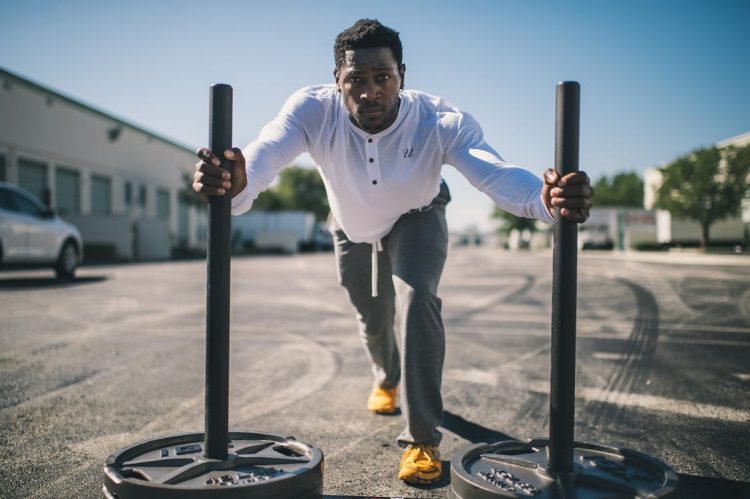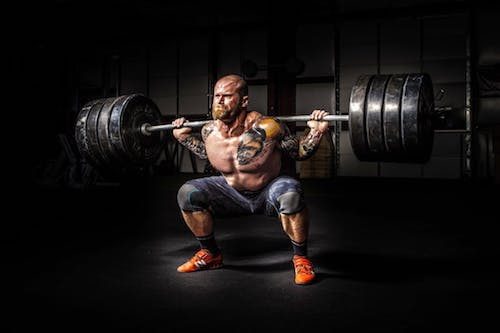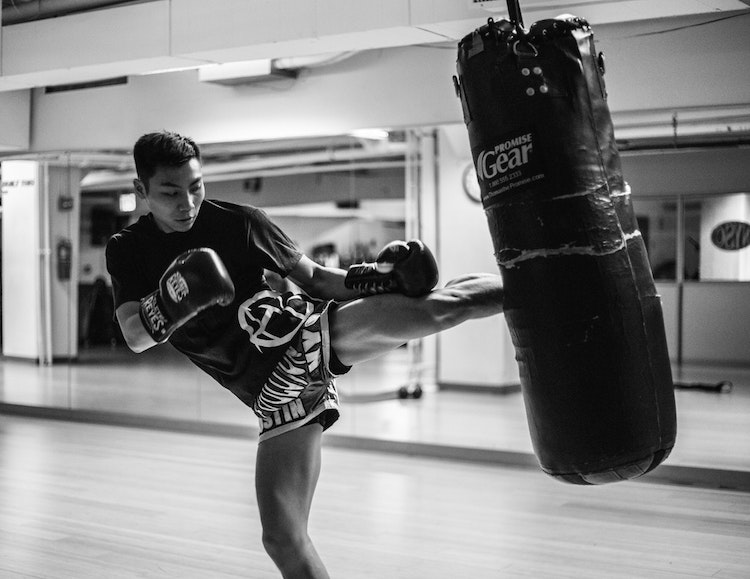High Performance Muscle
A huge bench press, gigantic arms, and tree trunk legs – these are the kinds of goals most lifters chase, but hypertrophy and maximal strength aren’t the end-all, be-all for football players, track athletes and other sports-focused trainees. As important as weight room work is for improving strength and speed, athletes need a more performance-oriented, sport-specific approach than the average meathead.
Fortunately, there are plenty of training tips athletes can take from powerlifters, Crossfitters, and even bodybuilders! While none of their training systems is ideal for other sports, they each contain elements that athletes can use to improve their performance on the track, pitch, or field. Taken from my background as an athlete, fitness model, and personal trainer, here are some of the most important aspects of an effective “anti-bodybuilding” lifting routine.
Strength and Power

Make no mistake, strength and power output are crucial in football, rugby, throwing, and just about any other sport that involves short, explosive plays. Old-time coaches once thought heavy lifting was a surefire way to make their athletes “muscle-bound” and immobile, but good trainers have long since come around. If you need to heave an implement, knock skulls, or even just run fast, you should absolutely care about your maximal strength!
Now, how do you develop maximal strength? Through heavy-ass lifting! Truly, there are far more similarities than differences in the ways top powerlifters and elite football players and track and field athletes train for strength. Powerlifters may be a little less concerned with weight room injuries – since the lifting IS their bread and butter work – but the principles of strength training apply just the same.
Exercise Selection

Maximal strength is critical for most athletes, but shouldn’t they use different exercises from bodybuilders and powerlifters? Nope! At least not in most cases. The squat, bench press, and deadlift are three of the most basic, heavy movements you can perform, and they can all be done safely with proper form and good programming. They’ll allow you to use more weight and progress faster than anything else, as well – a crucial consideration for athletes who may only be able to focus heavily on weight room work during their short off seasons.
Now, there are some substitutions that certain athletes may need to make. For instance, players with shoulder injuries may want to stick to the incline press or decline press, since the flat bench tends to aggravate such issues, and they’ll probably want to avoid overhead pressing, as well.
You might make similar substitutions for the squat. While the back squat IS the most effective exercise for building lower body strength, it doesn’t work well for every body type. Take the average basketball player, for example, who’s probably dealing with long legs and maybe even a shaky lower back. For this kind of build, a parallel squat (as opposed to a full-depth squat), a box squat, or even a front squat might be better for avoiding injury. Make note, however, that these substitutions are all still different types of squats! Unless you’re working around severe injuries, there’s little reason to completely abandon such basic and useful movement patterns. You’re not going to build anywhere near the same level of strength with lunges, machines, or other, “safer” alternatives.
Unilateral Work

While a squat, press, and pull should form the cornerstone of any athlete’s weight room routine, it will probably be necessary to include some one-legged and one-armed work, as well. Few if any sports involve picture-perfect, two-sided motions, and athletes need to build strength independently on both sides of their bodies.
Still, I don’t think you need to get as fancy as some coaches would have you believe. For the lower body, lunges, split squats, and step-ups are perfect for building unilateral strength in the quads, hamstrings, and glutes. For the upper body, you can simply perform any dumbbell press or row one side at a time. In addition to the heavy barbell work, these basic one-sided movements are more than enough to keep athletes healthy and strong as they perform unilateral movements in practice.
Programming

So, exactly how should an athlete program his or her lifting to make maximal strength gains while avoiding injury? Covering that question in full would require another article – or 5 or 10 – but in general, a basic progressive overload program works best in the off season. Going into the off season, athletes are probably a bit down in strength, but they’re eating and recovering well and are ready to make some serious gains.
For heavier exercise – squats and pulls in particular – stronger athletes should be able to handle 5-10 pound increases from week to week while performing 3-5 sets of 3-5 reps: a perfect rep range for building strength and power. Weaker athletes may need to take smaller jumps, and just about everyone will have to make slower progress on pressing movements, but the principle remains the same. Use low reps – but not max singles – and slowly add weight so that you can still perform the prescribed sets and reps.
In addition to those low rep sets, athletes who need either extra muscle mass or better condition – almost everyone! – should also perform a few sets with higher reps afterward. 3 sets of 8-10 is a good for most, and athletes who really need to pack on some weight should add volume from week to week, until they’re hitting 4, 5, or even 6 extra sets after their heavier work. And no, these sets won’t make athletes slow or “muscle-bound.” Assuming proper exercise selection and form, a squat, press, and pull will pack on muscle in the legs, glutes, hips, back, and shoulder girdle – all of the critical areas for athletes concerned with strength and speed!
Conditioning

We’ve covered strength-building, but what about conditioning? What kind of “cardio” should athletes do in the weight room? In my opinion, very little! Resistance training is meant to make athletes strong, but endurance training is best accomplished on the track, on the field, and during hard, drawn-out practices.
That sad, the Crossfit craze has demonstrated that circuits of barbell work and calisthenics can be incredibly effective for conditioning. Unlike many Crossfitters, however, I do NOT like to involve the highly technical Olympic lifts in this type of training! Doing high reps on the snatch, clean and push-press is a great way to get injured, especially when you’re already fatigued from the last umpteen sets of whatever else you’re doing.
I think a better way to use weights for conditioning is to combine several basic compound movements, along with perhaps some pull-ups, push-ups, crunches and other body weight exercises, into a high-rep, low-rest, puke-inducing circuit! It could be as simple as something like 10 reps each of squats, overhead presses, bent rows, push-ups, and pull-ups, done for 8 circuits with as little rest as possible. It looks easy on paper, but even with light loads, this routine will have most athletes wishing they’d skipped practice!
Hypertrophy

Last but not least, we’ve got hypertrophy, or “muscle building” for those of you who rarely pick up a bodybuilding magazine. Are the old-time coaches right? Does muscle really make you slow on the field! No! When packed on in the right places, additional muscle mass will make an athlete stronger, faster, and more skilled at the specific movements he needs for his sport.
However, it’s probably pointless for most athletes to dedicate any significant amount of time to arm workouts, calf raises, pec flyes, and anything else that hypertophies the showier muscle groups. Many competitors are limited by specific weight classes, and assuming they’re already lean, they can’t really afford to ADD non-functional mass. And even for players who don’t have to stay at specific weights, any body mass that doesn’t contribute to enhanced performance, be it muscle or fat, is just going to be a hindrance while running, jumping, and tackling.
Still, those basic strength movements are going to build the vast majority of muscle any athlete needs. Done with sufficient volume – and assuming adequate nutrition, the heaviest exercises are also the ones that will produce the most growth. When an athlete does need extra mass in weak areas – typically the hamstrings, glutes, lats and upper back – the solution is simple: high volumes of the most basic movements for those muscles! For those lower body posterior chain muscles, glute-ham raises, Romanian deadlifts and back raises are king. For the upper back – a common weak spot for athletes who’ve benched too heavy and too often, my prescription is rows, rows, and more rows, followed by plenty of pull-ups.
Overall, there’s really no need to over complicate lifting for athletics – despite what many high-priced gurus would have you believe! Stick to the basics in the weight room, and keep your performance goals in mind as you select exercises, rep schemes, and progression goals. Leave the complex training methods for your actual skills practice, and let your coach be your guide!











